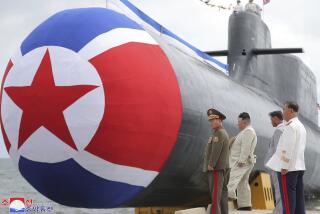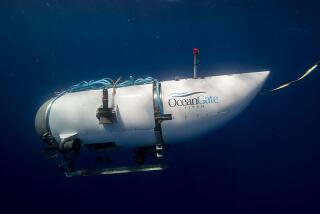Navy Report on Sub to Leave Question of Criminality Open
- Share via
WASHINGTON — A preliminary Navy report on the U.S. submarine Greeneville’s fatal collision with a Japanese fishing vessel will leave open the question of whether the sub’s commander or other crew members will face criminal charges, a senior Navy official said Friday.
The report, expected within days, will provide an initial look at what may have caused the accident and recommend how the Navy is to proceed in assessing responsibility--and what might be done to prevent a recurrence.
Nine people were lost, and are now presumed dead, after the nuclear attack submarine Greeneville rammed the trawler Ehime Maru on Feb. 9 in the waters nine miles south of Honolulu.
Japanese survivors and government officials have expressed outrage at the accident and have pushed for a full, formal investigation.
Because of the loss of life--and the destruction of the 190-foot trawler--the Navy may face lawsuits from the victims’ families and the ship’s owners to recover damages.
Adm. Thomas B. Fargo, commander of the U.S. Pacific Fleet and the author of the report, could recommend that the Navy undertake a quick, less-formal investigation or a longer one more akin to a court proceeding.
But the Navy official said that, given the circumstances, Fargo undoubtedly will choose a means that will continue to explore whether the skipper and crew were guilty of any wrongdoing.
“Given the damage and the loss of life, there’s really no choice,” said the official, who asked not to be identified because the investigation is confidential.
Repeated Periscope Sweeps Are Noted
At a Senate hearing Wednesday, Fargo said that he could not understand how the crew, which conducted periscope and sonar sweeps of the area, could have failed to notice the trawler.
But two civilian passengers aboard the sub said that they watched as Cmdr. Scott Waddle conducted repeated periscope sweeps, as did the deck officer. The sonar equipment also appears to have been functioning at the time of the accident.
Fargo has received an initial fact-finding report from Navy investigators and was expected to deliver it, with his conclusions, on Friday.
But the expected announcement was called off Friday afternoon, and Navy officials said Fargo is continuing to consider the alternatives.
Meanwhile, the National Transportation Safety Board disclosed Friday in its separate investigation that the Greeneville had tracked several other ships in the area before the collision.
John Hammerschmidt, head of an NTSB group probing the accident, said at a news conference that sonar operators told investigators the sub had made several “surface contacts” before the crash.
One of the civilian visitors on the sub, Texas oilman John Hall, said in a television interview Thursday that he noticed that the sub had made several such contacts before the collision.
Earlier accounts of the trip by Navy officials and civilian investigators had given no indication that there were any other ships in the area.
If the sonar contacts were made shortly before the collision, that might suggest other ships were nearby and that the crew was not sufficiently alert to the possibility of an accident.
The Greeneville left port about 8 a.m. and collided with the trawler at 1:45 p.m.
But Hammerschmidt declined to specify how many surface contacts there were or where the vessels might have been in relation to the submarine.
The Ehime Maru left Honolulu Pier about noon on the day of the accident and about 15 minutes later set a course of 166 degrees,which it followed until the time of the accident.
The Japanese vessel was traveling at an estimated 12 mph when it was struck.
Trawler May Have Been Hard to See
Some naval experts have theorized that the angle of approach may have meant the trawler was headed directly at the sub before the two vessels collided.
At that angle, the fishing boat’s narrow, white-painted bow may have been missed in the periscope sweeps of the surface, or it may have blended in with the island behind it.
But an NTSB spokesman said the board’s investigators had not yet been able to plot the locations of the vessels to see if that theory holds up.
“We really don’t have the exact locations,” said spokesman Keith Holloway. “We haven’t plotted it out. We have to figure that out.”
Meanwhile, federal investigators in Washington reported that toxicology tests showed no signs of illegal drug use among the Greeneville crew or the crew of the Ehime Maru.
The Navy’s remotely operated submersible Scorpio II traveled aboard another vessel through choppy seas to the site of the accident Friday in hopes of getting a first look at the wreckage of the Ehime Maru, which took only minutes to sink in 1,800 feet of water.
Scorpio’s operators studied a similar fishing vessel that happened to be in Honolulu before heading out.
The box-like submersible was deployed underwater Friday afternoon.
“It’s pretty rough out there,” said Petty Officer Eric Hedaa, a spokesman for the 14th Coast Guard District, estimating waves of 10 to 12 feet with winds a stiff 20 to 30 knots.
Although the Coast Guard announced plans to call off its search for survivors on Thursday, the rescue effort continued Friday under pressure from the Japanese government.
A Navy cruiser and a P-3 Orion patrol aircraft, along with a Coast Guard cutter, patrolled the waters for an eighth day, Hedaa said.
In all, 21,000 square nautical miles of ocean have been scanned from the air and by sea.
*
Times staff writer Richter reported from Washington, and Times special correspondent Essoyan from Honolulu.
More to Read
Sign up for Essential California
The most important California stories and recommendations in your inbox every morning.
You may occasionally receive promotional content from the Los Angeles Times.














